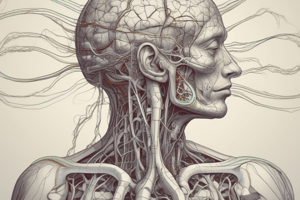Podcast
Questions and Answers
What percentage of blood supply to the brain comes from the 2 carotid arteries?
What percentage of blood supply to the brain comes from the 2 carotid arteries?
80%
What happens to the vasculature when there is swelling in the brain?
What happens to the vasculature when there is swelling in the brain?
It is compressed against the skull, impairing perfusion and causing widespread hypoxia.
What is the approximate volume of cerebral spinal fluid surrounding the brain and spinal cord?
What is the approximate volume of cerebral spinal fluid surrounding the brain and spinal cord?
125-150 mL
What is the function of the ependymal cells in the CNS?
What is the function of the ependymal cells in the CNS?
What is the purpose of the choroid plexus in the CNS?
What is the purpose of the choroid plexus in the CNS?
What is one of the functions of the CSF in terms of waste removal?
What is one of the functions of the CSF in terms of waste removal?
Flashcards are hidden until you start studying
Study Notes
Blood Supply to the Brain
- Blood is supplied to the brain by 2 carotid arteries (80%) and 2 intervertebral arteries (20%)
- These arteries form a redundant circulatory loop that spreads over the brain cortices, entering the tissue from the parenchyma perpendicular to the brain surface
- Cerebral edema (swelling) compresses the vasculature against the skull, impairing perfusion and causing widespread hypoxia
- The extent of hypoxia and damage depends on collateral circulation from unaffected areas
Cerebral Spinal Fluid (CSF)
- CSF is a ~125-150 mL fluid surrounding the brain and spinal cord
- CSF fills the "open" spaces within the Central Nervous System (CNS)
- CSF is produced by choroid plexus cells in CNS ventricles at a rate of ~500 mL/day, with constant turnover
- CSF drains into the venous and meningeal lymphatic system
Functions of CSF
- Buoyancy: provides support to the brain and spinal cord
- Protection: acts as a shock absorber and protects the CNS from mechanical injuries
- Chemical stability: helps maintain a stable pH and removes waste products
- Creates pressure gradient that facilitates perfusion
Composition of CSF
- Contains proteins (albumin, antibodies) and cells common in the periphery but not found in the CNS tissue
- Sampling CSF can provide clues about what's happening in the CNS tissue
Ependymal Cells
- Specialized epithelial cells that form a barrier between CSF and CNS
- Allow for the transfer of nutrients and components from CSF into the brain
Studying That Suits You
Use AI to generate personalized quizzes and flashcards to suit your learning preferences.




